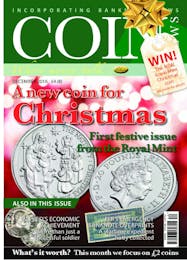Faking it
THE Royal Mint Museum recently announced that they were to display one of their choicest pieces—a sovereign from the curtailed reign of Edward VIII; one of 49 coins featuring the Monarch that the museum holds, coins that were all ready for mass production but which never made it in to circulation due to the abdication. Regular readers will know that a similar coin made headlines back in 2014 when it became the most expensive British coin ever to be sold at auction fetching a staggering £516,000 (including premium) when it was sold as part of the Hemisphere Collection at A. H. Baldwin & Sons in May of that year. Such was the interest in the Edward VIII coin going on display at the Royal Mint Experience in South Wales that it too made national headlines both on and off-line and COIN NEWS was asked to chat about the importance of the piece on a variety of radio shows. One of the questions we were asked was “if this is so rare how can you buy coins featuring Edward VIII on line for just a few pounds?”
Now all we numismatists know that such coins readily available on eBay and the like are “patterns” or “fantasy” pieces sold to ensure that collectors who could never afford the real thing can complete their date run collections with no gaps, and the listings on such coins generally do describe them as exactly what they are—there seems to be no intent on the part of the seller to deceive. Indeed one could also argue that anyone who knows about coins would never think that they could be real Edward VIII coins at such a ridiculously low price anyway. This is of course true, as is the fact that copy coins, be they fantasy pieces of coins that were never produced in large numbers (if at all) or direct copies of coins that a regular collector would find too expensive (a Vigo five guineas, a “Una and the Lion”, etc.) have been around for years and do serve a useful purpose. We wouldn’t argue with that. However, we would argue that in some cases certain copies can actually be extremely dangerous. Many of the copies out there could never fool anyone into believing that they are the real thing, they are not intended to be exact replicas but rather modern strikes of an old coin and they look like exactly that, however, some are fiendishly close to the original and whilst the manufacturer or original seller might have no intention to trick or cheat, there can be no doubt that there are some out there who are happy to take full advantage of others by ageing a copy, maybe by giving it a bit of a worn, used feel or by treating it chemically to give it a particular lustre etc. Of course some manufacturers will do that anyway and some of the coins emanating from Asia in particular look as if they’ve been around for decades even though they may have been made last week. Not that this is done to deceive (of course not, honest) but rather to give the copy a look that will blend into the rest of your collection. The fact that someone with fewer morals may come along, buy such a copy and then sell it on as an original is of no concern to the original maker at all.
Such aged copies do pose a problem for our hobby. Out and out fakes are of course illegal, but copies? Well as has been said, they have their place, but when does a copy stop being a space filler and actually become a counterfeit coin? The American Government has recently recognised this issue with the Federal Trade Commission, the nation’s consumer protection agency, last month (October) issuing final rules amending the Hobby Protection Act regarding coins and political items (such as badges). Now any items manufactured as copies and sold in the United States MUST be clearly labelled as such with the word COPY on them—this was actually always the case under the act when it was originally brought in in 1973 (and added to in 2014) but now it seems it will be more vigorously enforced and, apparently, will be extended to include “imitation” items too—so one assumes that includes fantasy pieces although perhaps in this case “copy” is a little misleading as such coins aren’t actually copied from anything at all! There are some who will no doubt argue that having the word COPY on a space filler will detract from its appeal but they will be the ones who would never be fooled by such a coin anyway and thus feel the rules are pointless but on this occasion I have to disagree with them—as manufacturing techniques get better and distribution channels get more diverse there is no doubt that more protection is needed and I for one would like to see the FTC rules or similar adopted over here, if not worldwide. A good copy is an excellent thing to have if you can’t find or afford an original—a fake coin can only damage our hobby and the more we can do to stop the fakes getting out there the better.

Archives
-
2024 (15 articles)
-
2023 (55 articles)
-
2022 (44 articles)
-
2021 (59 articles)
-
2020 (80 articles)
-
2019 (50 articles)
-
2018 (49 articles)
-
2017 (46 articles)
-
2016 (54 articles)
-
2015 (44 articles)
-
2014 (62 articles)
-
2013 (75 articles)
-
2012 (74 articles)
-
2011 (81 articles)
-
2010 (131 articles)
-
2009 (91 articles)
-
2008 (89 articles)
-
2007 (75 articles)
-
2006 (76 articles)
-
2005 (19 articles)
-
2004 (11 articles)
-
2003 (23 articles)
-
2002 (16 articles)
-
2001 (11 articles)









